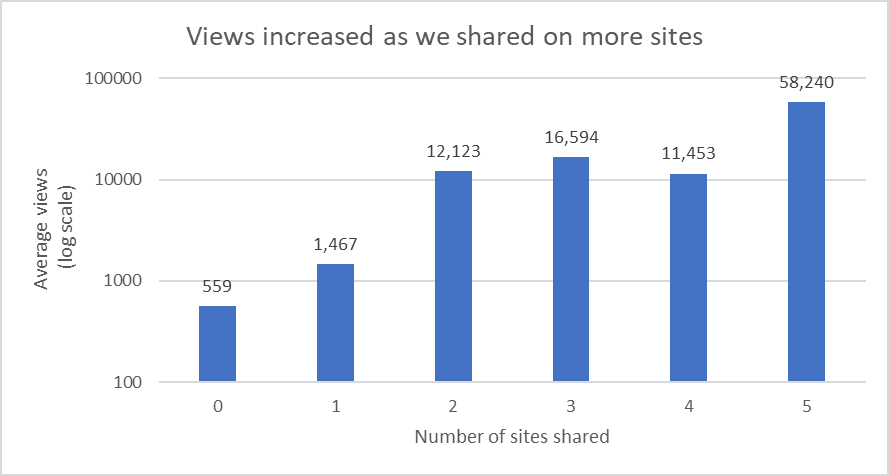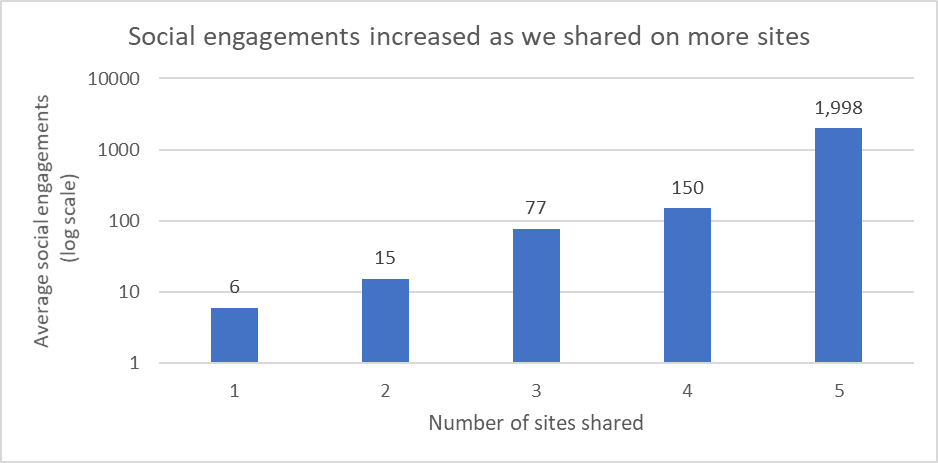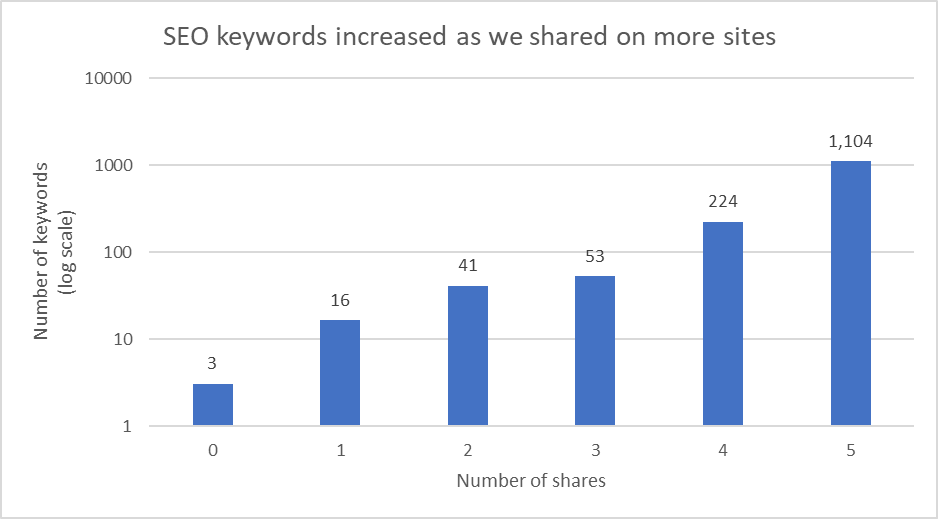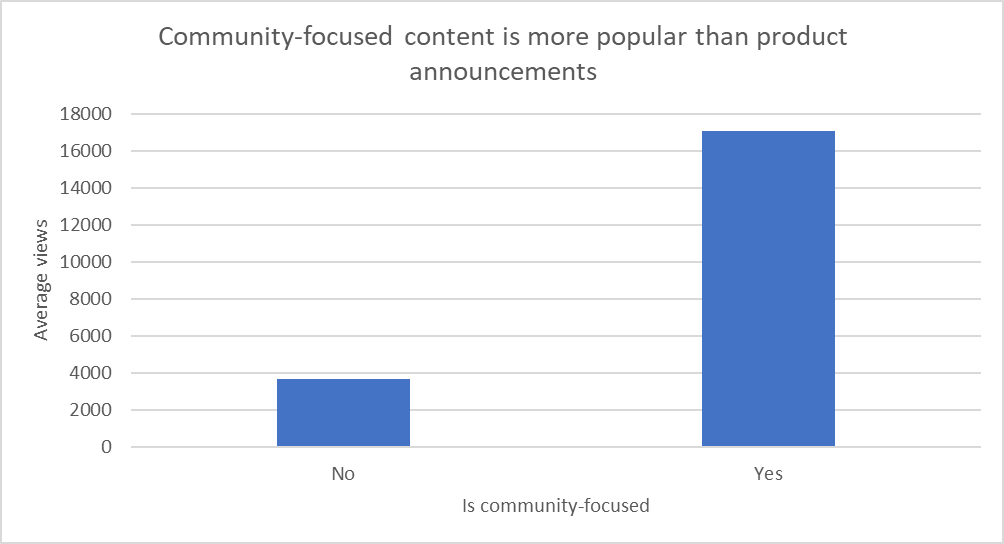It’s tempting to think that if you build great content, then people will come. This is especially enticing when time and budgets are limited. The hard reality is that most software developers don’t spend their time reading marketing material. If your strategy for distributing content is to post it on your corporate blog, then your audience will mostly be the people who read your blog. Is that really who you want to reach? To reach new customers, you need to go beyond the confines of your existing channels. Instead of waiting for customers to come to you, it’s better to reach out to them.
In this article, you’ll learn how Rollbar was able to generate 20x more traffic by sharing content on popular third-party sites. We’ll explain how this simple tactic delivered huge results and share tips to help you achieve the same.
“Marketing to developers is a unique challenge because it is about being helpful, not pushy. One of the best ways to do that is to provide useful, relevant, and high-quality content. Jason at Dev Spotlight has been doing an excellent job helping us creating such content. Not only that, he’s been actively helping distribute the content to our audience. 5 / 5 highly recommend.” - Tyler Cascade, Director of Marketing at Rollbar
Introduction to Rollbar
Rollbar offers one of the most popular error monitoring solutions for software applications. It alerts developers to these errors and helps them fix those problems quickly. The company is headquartered in San Francisco and has 28 employees as of 2018. Developers love their product and they’ve grown fast, but even at over 100,000 users, they currently reach less than 1% of the total developer market. Their challenge is in reaching those who have never heard of “error monitoring” as a product category.
When Rollbar first contracted our team at Dev Spotlight to produce developer marketing content, they had no official content strategy. The founders and engineers would write blogs for feature launches and when opportunity allowed, but there was no formal content pipeline in place. They primarily shared content on their corporate website and blog. They sent a monthly newsletter email and occasionally tweeted on their corporate account.
Developing a content strategy for developers
The main goals for the Rollbar marketing team are to generate demand and leads for their product. In order to achieve this goal, we planned campaigns around several themes. We recognized that our audience is often looking for content specific to their programming language, so we created content to align with the launch of SDKs for those languages. For example, Rollbar has SDKs for JavaScript, Ruby, Java, Python, PHP, and so on. We created several types of blog posts and landing pages around each of these theme areas. When a new SDK was ready to launch, we created one or more types of content to complement it such as a blog to announce the SDK, a tutorial with working code examples, documentation, landing pages, and a community-focused blog to compliment the topic and drive traffic.
For community and social media content, we sought to enhance Rollbar’s image around error monitoring by becoming a leading voice in best practices for writing bug-free code and how to effectively monitor apps in many languages. We leveraged unique data that Rollbar collected from thousands of projects to identify the most common errors, how to fix them, and prevent them from occurring again. We distributed the content in channels and sites that developers frequently visit including:
- Partner blogs like CircleCI
- Dzone
- Dev.to
- Hacker News
- and more!
Impact on traffic, social engagement, and SEO
Sharing content on third-party sites increased traffic the more places we shared it. This makes intuitive sense because the more you share it, the more opportunity people have to view it. What’s more remarkable is that it follows an exponential growth pattern, so a little effort can lead to outsize results. On social media, only about 1% of people create content, so you have potential to reach far more numerous readers.
Below, you can see our results which show the average number of views based on the number of sites we shared the blog on. Sharing on a site means posting an update or tweet, submitting links to an aggregator and syndicating content. The view counts combine Google Analytics page views and views reported on syndication sites like Dzone and Dev.to. For example, if shared an article on DZone and Dev.to that would count as two sites.

Sharing to just two other sites led to a 20x increase in traffic on average, compared to not sharing at all. This does not require a huge time investment and delivers real results. When we shared content on five other sites, we saw the highest number of views and a 100x increase in traffic.
The absolute numbers will vary based the size of your market and communities you can reach. We’ve seen clients start at a different average baseline and still see large traffic increases after sharing. For example, check out how we helped Loggly reach 1M developers.
We also saw this exponential growth pattern on social engagements. The engagements we counted include likes, retweets, upvotes, and comments as reported on BuzzFeed or through the site itself. One article got over 8,000 claps on Medium, but we didn’t include it because a reader can leave multiple claps.

What’s also remarkable is that content originally created for sharing on social media also performed better on organic search. There is some debate about how much social media is a ranking factor in Google search, but it’s clear there is a correlation.
As we shared the content and as it generated more engagement on social platforms, Google also ranked the content higher and for a greater number of keywords (as reported by SEMRush). We know backlinks are good for ranking, and perhaps social engagement is as well. This means even if you are creating content primarily for SEO, it will likely perform better if you take the time to share it on other sites.

Topics that performed best
The topic you choose to write about is a key ingredient in success. Not all topics are created equal. While you may want people to sign up for your product right away or read about a new feature you just launched, this may only appeal to a narrow audience. Rollbar got more views (on average) with topics that were community-focused rather than focused primarily on our product. Community-focused content is written for a wider audience at the top of the funnel and starts with popular topics. While we may want our product announcements to have wide appeal, this content didn’t drive as much traffic.

To identify topics of interest, we looked at trends like the most popular frameworks for each of our target languages using tools like hotframeworks.com. We also picked topics where we add unique value given our expertise in error monitoring or can leverage the data we’ve collected from thousands of projects. Below, you can see Rollbar’s most popular articles of 2018. You’ll notice they are on topics interesting to the developer community at large.
- Custom error handling for Angular – 63,000 views – traffic primarily from organic search where it ranked highly for keywords like “angular error”
- Top 10 JavaScript errors from 1000+ projects (and how to avoid them) – 58,000 views – traffic primarily from social media sites like Reddit and Medium
- Most popular Java web frameworks – 52,000 views – traffic primarily from syndication on industry sites like DZone
Once we have the reader’s attention, we can generate demand by getting them thinking about common problems developers face - such as the need to fix errors faster. Now we have an opportunity to raise their curiosity about our solution. Even though product-specific content gets fewer views, it’s important at the next stage in our marketing funnel to turn readers into leads.
Best practices for sharing content with developers
To create content for software developers and DevOps engineers, we recommend following these best practices:
- Identify and join sites that are popular among developers Learn the places where developers hang out online and join those communities. Popular sites include subreddits like r/programming and r/webdev, Hacker News, Dev.to, Dzone, and more.
- Understand the audience and which content performs best Look at the top-ranked articles in those communities for ideas on topics that resonate. Learn the audience by reading the articles and forums, look at the Alexa traffic stats, or a demographic poll of their users. Use this knowledge to determine the type of content, level of depth, and tone that will work best for this audience.
- Pick topics with broad appeal that leverage your unique expertise Instead of starting with a product-specific topic and then look for places to post it, consider which topics have most interest to the community. This can help you create content that meets market needs and earn higher view counts and engagement rates. Leverage your company’s expertise and data to gain credibility and share unique insights.
- Add value to communities and don’t spam Be an active and contributing member of communities you join. It’s best to encourage organic submissions, but if you do self-promote read the community guidelines. For example, Reddit rules recommend that “10% or less of your posting and conversation should link to your own content”. Subreddits also have their own specific rules. Lastly, set an alert on brand mentions to track community discussions and join in if needed.
- Encourage (or hire) expert writers who understand technology and the industry Founders and engineers in your company make great writers because they understand your niche better than anyone. It’s worthwhile, but often difficult, to pull them away from product development and operations. To expand your reach, consider hiring experts who represent your target personas and who understand the technologies that your product integrates with. Not only does this broaden your reach, but it also sets a vision of what’s possible and how to achieve it.
Dev Spotlight focuses on creating and sharing content for developers and DevOps engineers. We have dozens of experts in frontend development, infrastructure, DevOps, and more. We can help you put together a content strategy and create content that’s tailor-made for the communities you want to reach.
Read about how we helped Loggly attract over 1M visitors with an ultimate guide and then check out our services to learn how we can help you better engage developers.

